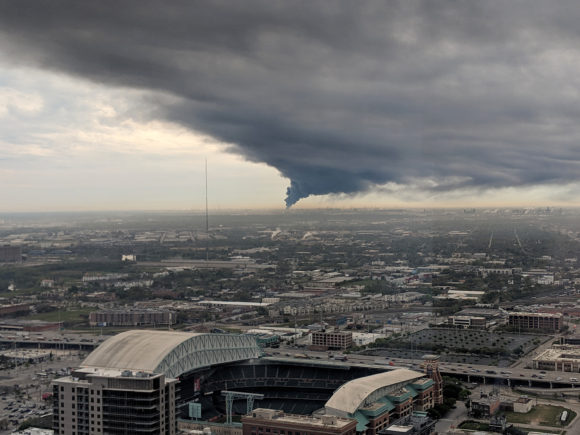Firefighters confronted with the worst Gulf Coast industrial disaster in 14 years had to call on outside sources to augment their supply of the special foam required to extinguish chemical blazes.
Intercontinental Terminal Co. confirmed it appealed to other companies for foam during the fire that erupted on March 17 and ravaged its chemical storage complex in Houston’s eastern suburbs for four days. Almost two weeks after the calamity began, local officials are questioning whether ITC had the proper equipment and personnel in place to handle such an event.
“It just seems that they had an incredible amount of difficulty doing something they should have been prepared to do,” said Harris County Commissioner Adrian Garcia, whose precinct encompasses the disaster site. “They have been operating at the minimum requirements. They are only required to have so much foam. This fire proved to be more than the foam they were required to have.”
ITC, a unit of Japanese conglomerate Mitsui & Co., sought additional foam from third-party sources “for the entire event,” Brent Weber, the senior vice president of sales and marketing who’s been the face of the company’s response effort.
However, Weber said ITC never ran short of foam. The entities ITC called upon included Channel Industries Mutual Aid, a Houston-area cooperative that lends rescue trucks and other gear when a member company has an emergency.
Foam Supplies
“I don’t have the specific numbers but I can tell you this, at no time were we low on foam,” Weber said. “We continued throughout the fire fighting process to bring in all the foam that we needed to fight the fire.”
U.S. Fire Pump, the Louisiana-based company the ITC brought in to help suppress the blaze, didn’t respond to requests for comment. The U.S. Chemical Safety Board, the Labor Department’s Occupational Safety and Health Administration and Harris County’s fire marshal have launched investigations of the incident.
“Ultimately, this is going to be a game changer for our industry and this country because of the duration and because of the amount of resources extended,” said Shane Stuntz, a senior emergency-response specialist at Royal Dutch Shell Plc. “Aspects of this response are going to be in training sessions for years to come.”
Falling Soot
The fire cast a mile-high plume of inky black smoke over the fourth-largest U.S. city that dropped shards of grimy soot on homes and cars. On the second night of the blaze, a dip in water pressure allowed the conflagration to intensify and engulf more storage tanks.
After the blaze was extinguished on March 20, clouds of cancer-causing benzene prompted take-shelter alerts in Deer Park and other suburbs, shutting down schools and highways, and paralyzing everyday life for tens of thousands of people.
The Houston Ship Channel was completely shut for three days because of benzene alerts and chemical contamination and has yet to fully reopen. Every day the city’s gateway to the Gulf of Mexico was closed cost the economy $300 million, said Garcia, a former sheriff for the third-largest U.S. county.
In addition to benzene, toluene and xylene were among the dangerous chemicals released into the air, the Texas attorney general’s office said in a lawsuit filed against ITC.
“There’s never a minor mistake that a heart surgeon will ever be allowed to make,” Garcia said. “He’s got to be perfect because he has the lift and well-being in his hand. These chemical companies that have these type of volatile toxic type of chemicals are equivalent to an industry heart surgeon.”
Was this article valuable?
Here are more articles you may enjoy.


 CoreLogic Report Probes Evolving Severe Convective Storm Risk Landscape
CoreLogic Report Probes Evolving Severe Convective Storm Risk Landscape  Johnson Controls Unit to Pay $750M to Settle ‘Forever Chemicals’ Lawsuit
Johnson Controls Unit to Pay $750M to Settle ‘Forever Chemicals’ Lawsuit  Harvard Study Again Stirs the Pot on Demotech Ratings of Florida Carriers
Harvard Study Again Stirs the Pot on Demotech Ratings of Florida Carriers  Dog-Related Injury Claim Payouts Hit $1.12B in 2023, Report Shows
Dog-Related Injury Claim Payouts Hit $1.12B in 2023, Report Shows 